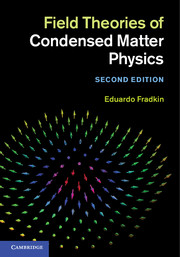Book contents
- Frontmatter
- Contents
- Preface to the second edition
- Preface to the first edition
- 1 Introduction
- 2 The Hubbard model
- 3 The magnetic instability of the Fermi system
- 4 The renormalization group and scaling
- 5 One-dimensional quantum antiferromagnets
- 6 The Luttinger liquid
- 7 Sigma models and topological terms
- 8 Spin-liquid states
- 9 Gauge theory, dimer models, and topological phases
- 10 Chiral spin states and anyons
- 11 Anyon superconductivity
- 12 Topology and the quantum Hall effect
- 13 The fractional quantum Hall effect
- 14 Topological fluids
- 15 Physics at the edge
- 16 Topological insulators
- 17 Quantum entanglement
- References
- Index
13 - The fractional quantum Hall effect
Published online by Cambridge University Press: 05 March 2013
- Frontmatter
- Contents
- Preface to the second edition
- Preface to the first edition
- 1 Introduction
- 2 The Hubbard model
- 3 The magnetic instability of the Fermi system
- 4 The renormalization group and scaling
- 5 One-dimensional quantum antiferromagnets
- 6 The Luttinger liquid
- 7 Sigma models and topological terms
- 8 Spin-liquid states
- 9 Gauge theory, dimer models, and topological phases
- 10 Chiral spin states and anyons
- 11 Anyon superconductivity
- 12 Topology and the quantum Hall effect
- 13 The fractional quantum Hall effect
- 14 Topological fluids
- 15 Physics at the edge
- 16 Topological insulators
- 17 Quantum entanglement
- References
- Index
Summary
In this chapter we discuss the theory of the fractional quantum Hall effect (FQHE). The explanation of this phenomenon has required the development of completely new ideas and methods. The concept of fractional statistics has become a crucial element of the theory.
The physical system involves fermions in strong correlation in the absence of time-reversal symmetry. The treatment of systems with these features cannot be achieved successfully within the conventional Hartree–Fock approach to correlations in condensed matter physics. A new condensed state of matter, the Laughlin state, had to be discovered.
The Chern–Simons gauge theory, which has already been discussed in Chapter 10, has come to play an essential role in the theory of the FQHE, both as a way to describe the low-energy phenomena and as a theoretical tool to explain the most important features of the problem.
We begin with a detailed description of the theory of the Laughlin wave function, which is followed by the field-theory approaches to the FQHE.
The Laughlin wave function
In the last two sections of the previous chapter we considered the problem of electrons moving on a 2D surface in the presence of a perpendicular magnetic field. We assumed that the electron density was such that an integer number of Landau levels (or bands) would be completely filled. Because the system has an energy gap, the interactions do not play a very important role. In fact, a perturbative expansion (in powers of the coupling constant) around a state with one filled Landau level (or more) is likely to be well behaved. Since all processes involve exciting one or several electrons across the gap, the energy denominators are always different from zero. The ground-state wave function for the interacting system is smoothly connected to the ground-state wave function of the non-interacting system. The arguments of the last three sections of Chapter 12 indicate that the topological properties of the wave function for the interacting and the non-interacting systems will then be the same. In other words, naive perturbation theory is a good approximation in this case.
- Type
- Chapter
- Information
- Field Theories of Condensed Matter Physics , pp. 480 - 535Publisher: Cambridge University PressPrint publication year: 2013



